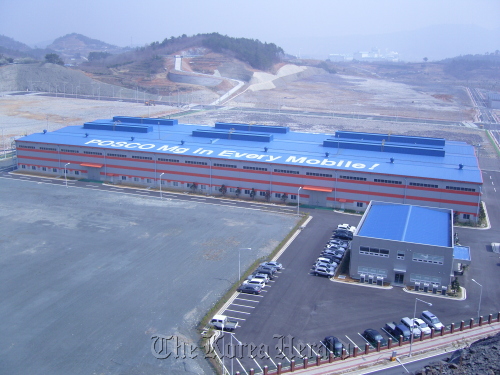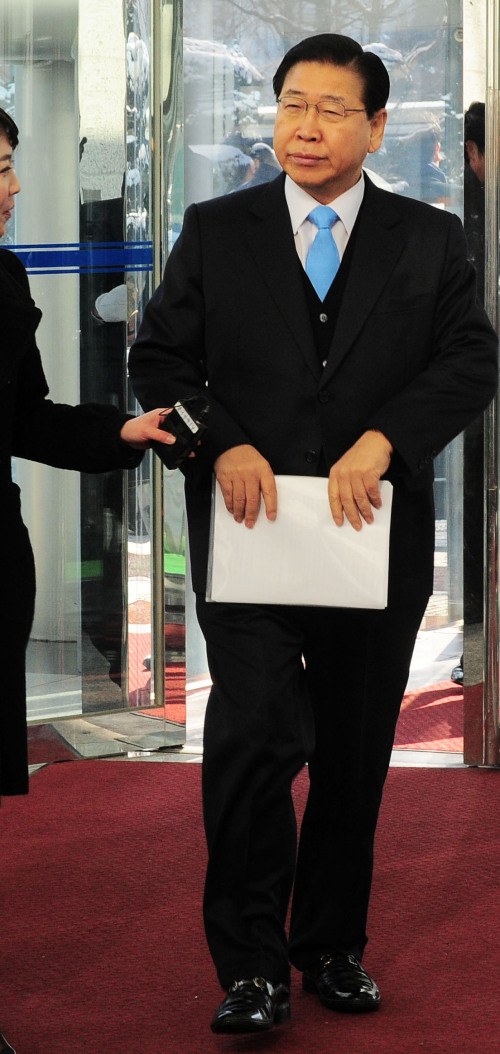Steelmaker boosts magnesium capabilities in its diversification drive
As magnesium alloys emerge as next-generation material for vehicles, POSCO, the world’s fourth-largest steelmaker, is betting on the metal to fuel the next stage of its drive to become an all-round materials developer.
While the market for magnesium alloys remains relatively small, such materials have become key candidates for use in automobiles and aircraft due to their properties such as lightness and high strength-to-mass ratio.
In addition, magnesium alloys are said to be 25 times more efficient than aluminum at absorbing vibration.
POSCO as a conglomerate has been expanding outside of its traditional boundaries of operation for some time through its many subsidiaries whose businesses range from construction and chemicals to information technology.
For POSCO alone, however, steel remains the company’s main source of revenue.
As such, the company has branched out into nonferrous metals to diversify its portfolio. While POSCO has diverse nonferrous metal businesses, its operations concerning magnesium have attracted the most attention within the industry, as well as from the government.
In August 2010, the steelmaker was selected by the Ministry of Knowledge Economy as the lead organization in the project developing magnesium alloys for transport, conducted under the ministry’s World Premier Materials or WPM program.
The program, into which the government will inject 1 trillion won ($89.7 billion), aims to develop and commercialize new materials in order to secure more than 30 percent share of the global market for such materials by 2018.
The WPM program concerning magnesium aims to develop materials and processes required for producing ultra-light magnesium alloys for transport that will improve the fuel economy of vehicles and reduce the environmental impact of such devices.
“The company plans to increase sales of magnesium products to 3 trillion won once the project, and related facilities investments are completed,” a POSCO official said.
“At present such products are mainly sold to portable electronics makers, but the company plans to diversify buyers to auto parts and home appliance makers.”
While the company’s inclusion into the WPM program came only last year, the steelmaker’s related plans go back to 2002.
Since then the company has been working with the Research Institute of Industrial Science and Technology to develop related technologies. As a result, the company was able to set up the world’s first integrated production line for magnesium.
“Having successfully produced 0.4-millimeter-thick plates for electronic devices such as mobile phones and cameras on a pilot-basis, the company has accumulated world-class technologies in the field,” the POSCO official said.
POSCO’s efforts have not remained within the boundaries of research and development.
In 2007, the company completed a plant capable of producing 3,000 metric tons of magnesium plates in Suncheon, South Jeolla Province.
As magnesium alloys emerge as next-generation material for vehicles, POSCO, the world’s fourth-largest steelmaker, is betting on the metal to fuel the next stage of its drive to become an all-round materials developer.
While the market for magnesium alloys remains relatively small, such materials have become key candidates for use in automobiles and aircraft due to their properties such as lightness and high strength-to-mass ratio.
In addition, magnesium alloys are said to be 25 times more efficient than aluminum at absorbing vibration.
POSCO as a conglomerate has been expanding outside of its traditional boundaries of operation for some time through its many subsidiaries whose businesses range from construction and chemicals to information technology.
For POSCO alone, however, steel remains the company’s main source of revenue.
As such, the company has branched out into nonferrous metals to diversify its portfolio. While POSCO has diverse nonferrous metal businesses, its operations concerning magnesium have attracted the most attention within the industry, as well as from the government.
In August 2010, the steelmaker was selected by the Ministry of Knowledge Economy as the lead organization in the project developing magnesium alloys for transport, conducted under the ministry’s World Premier Materials or WPM program.
The program, into which the government will inject 1 trillion won ($89.7 billion), aims to develop and commercialize new materials in order to secure more than 30 percent share of the global market for such materials by 2018.
The WPM program concerning magnesium aims to develop materials and processes required for producing ultra-light magnesium alloys for transport that will improve the fuel economy of vehicles and reduce the environmental impact of such devices.
“The company plans to increase sales of magnesium products to 3 trillion won once the project, and related facilities investments are completed,” a POSCO official said.
“At present such products are mainly sold to portable electronics makers, but the company plans to diversify buyers to auto parts and home appliance makers.”
While the company’s inclusion into the WPM program came only last year, the steelmaker’s related plans go back to 2002.
Since then the company has been working with the Research Institute of Industrial Science and Technology to develop related technologies. As a result, the company was able to set up the world’s first integrated production line for magnesium.
“Having successfully produced 0.4-millimeter-thick plates for electronic devices such as mobile phones and cameras on a pilot-basis, the company has accumulated world-class technologies in the field,” the POSCO official said.
POSCO’s efforts have not remained within the boundaries of research and development.
In 2007, the company completed a plant capable of producing 3,000 metric tons of magnesium plates in Suncheon, South Jeolla Province.

While the plant allowed it to make headway in a market projected to undergo rapid expansion, the company is dependent on magnesium ingots imported from China.
As the company continues the drive to secure additional advantage in the market, POSCO is now working on a dolomite smelting plant in Gangwon Province, which holds more than 190 million tons of dolomite deposits.
Dolomite, calcium magnesium carbonate, is a key source of magnesium in commercial production of the metal.
“Once the plant is complete, the company will have an in-house source of 10,000 tons of magnesium ingots, replacing imports worth 35 billion won each year,” POSCO officials said.
“It will also complete our magnesium production system, allowing us to gain competitiveness in nonferrous metals ahead of the competition.”

Another nonferrous metal the company hopes to develop into a source of revenue is lithium.
In February last year, the company and the Ministry of Land, Transport and Maritime Affairs formed a partnership to develop technologies for extracting lithium from seawater.
The project is scheduled to run until March 2015 with 15 billion won investment each from the steelmaker and the ministry.
While nonferrous metals form a key part of POSCO’s growth strategy, related activities conducted by POSCO also serve to strengthen its core business of steelmaking.
In 2006, the company set up a mining firm NMC in New Caledonia, which holds the world’s largest nickel deposits, and nickel smelting firm SNNC in Gwangyang, South Jeolla Province.
By establishing the two firms, the company was able to secure a stable source of nickel, which takes up as much as 80 percent of stainless steel’s production costs.
The company also recently finalized a deal with India’s biggest ferrochrome manufacturer Indian Metals and Ferro Alloys regarding a joint venture producing 35,000 metric tons of the alloy.
Ferrochrome is an alloy of chromium and iron used in stainless steel production.
The joint-venture, 24-percent held by POSCO, will supply the Korean company with ferrochrome at lower-than-market prices for 25 years starting in 2012.
POSCO also established POS-HiMetal, a subsidiary producing ferromanganese in 2009. The company’s plant, which is scheduled for completion in September, will produce 75,000 tons of ferromanganese on an annual basis.
By Choi He-suk (cheesuk@heraldcorp.com)







![[Graphic News] More Koreans say they plan long-distance trips this year](http://res.heraldm.com/phpwas/restmb_idxmake.php?idx=644&simg=/content/image/2024/04/17/20240417050828_0.gif&u=)
![[KH Explains] Hyundai's full hybrid edge to pay off amid slow transition to pure EVs](http://res.heraldm.com/phpwas/restmb_idxmake.php?idx=644&simg=/content/image/2024/04/18/20240418050645_0.jpg&u=20240419100350)





![[From the Scene] Monks, Buddhists hail return of remains of Buddhas](http://res.heraldm.com/phpwas/restmb_idxmake.php?idx=652&simg=/content/image/2024/04/19/20240419050617_0.jpg&u=20240419175937)

![[KH Explains] Hyundai's full hybrid edge to pay off amid slow transition to pure EVs](http://res.heraldm.com/phpwas/restmb_idxmake.php?idx=652&simg=/content/image/2024/04/18/20240418050645_0.jpg&u=20240419100350)

![[Today’s K-pop] Illit drops debut single remix](http://res.heraldm.com/phpwas/restmb_idxmake.php?idx=642&simg=/content/image/2024/04/19/20240419050612_0.jpg&u=)